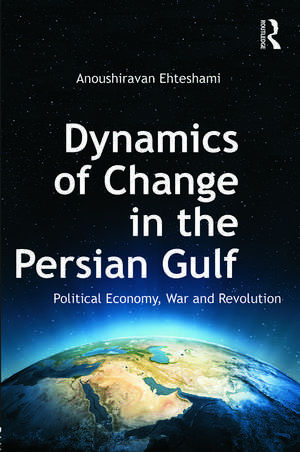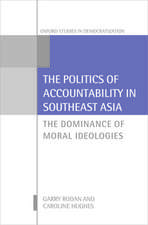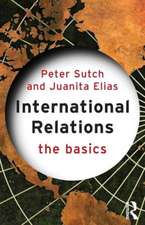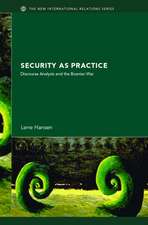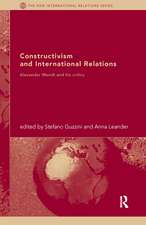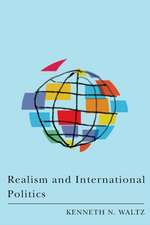Dynamics of Change in the Persian Gulf: Political Economy, War and Revolution
Autor Anoushiravan Ehteshamien Limba Engleză Paperback – 27 feb 2013
Systemic-oriented in its approach, the impact of war and revolution on the countries of the sub-region is discussed, and the ways in which these factors have shaped the security dilemmas and responses of the Gulf States is also explored. The role of oil is examined in terms of the impact of its income on these states and societies, and the manner in which oil has shaped the integration of these states into the global system. Oil has shrunk developmental time in these countries, and has accelerated generational shift. At the same time, it has created the dialectical relationship which now characterizes the difficult balance between prosperity and instability which is at the heart of the sub-region.
Casting new light on the workings of a strategically significant part of the international system, this book will be an essential resource for students and scholars of international relations, international security and Middle Eastern politics.
| Toate formatele și edițiile | Preț | Express |
|---|---|---|
| Paperback (1) | 299.52 lei 6-8 săpt. | |
| Taylor & Francis – 27 feb 2013 | 299.52 lei 6-8 săpt. | |
| Hardback (1) | 769.00 lei 6-8 săpt. | |
| Taylor & Francis – 5 mar 2013 | 769.00 lei 6-8 săpt. |
Preț: 299.52 lei
Preț vechi: 341.55 lei
-12% Nou
Puncte Express: 449
Preț estimativ în valută:
57.32€ • 59.77$ • 47.64£
57.32€ • 59.77$ • 47.64£
Carte tipărită la comandă
Livrare economică 20 martie-03 aprilie
Preluare comenzi: 021 569.72.76
Specificații
ISBN-13: 9780415657587
ISBN-10: 041565758X
Pagini: 304
Ilustrații: 25 black & white tables
Dimensiuni: 156 x 234 x 18 mm
Greutate: 0.45 kg
Ediția:New.
Editura: Taylor & Francis
Colecția Routledge
Locul publicării:Oxford, United Kingdom
ISBN-10: 041565758X
Pagini: 304
Ilustrații: 25 black & white tables
Dimensiuni: 156 x 234 x 18 mm
Greutate: 0.45 kg
Ediția:New.
Editura: Taylor & Francis
Colecția Routledge
Locul publicării:Oxford, United Kingdom
Public țintă
Postgraduate and UndergraduateCuprins
Preface Introduction Part I:Power Politics 1 Geopolitics of the Persian Gulf 2 The Persian Gulf from Cold War to the Post-Cold War Era 3 Regional Balance of Power and the Persian Gulf Part II: Political Economy 4 Oil and the Persian Gulf Economy 5 Globalization of the Persian Gulf 6 Asianization of the Persian Gulf Part III: Political Systems and Processes 7 Revolution and Regime Change in the Persian Gulf 8 Political Change in the Persian Gulf Oil Monarchies 9 Between Boundary and Frontier: Islam and Persian Gulf Politics Part IV: Conflict 10 Impact of Inter-State Conflict on Persian Gulf Relations 11 The Role of External Powers in Persian Gulf Security Relations 12 Militarization and Persian Gulf Security Conclusions
Notă biografică
Anoush Ehteshami is Professor of International Relations at Durham University, UK. He is Joint Director of the ESRC-funded Durham-Edinburgh-Manchester Universities’ Centre for the Advanced Study of the Arab World (CASAW), whose research focus since 2012 has been on the ‘Arab World in Transition’. He was the University’s Dean of Internationalisation, 2009-2011 and was the founding Head of the School of Government and International Affairs at Durham University (2004-9). He has been a Fellow of the World Economic Forum, and has been elected as a member of the WEF’s foremost body, the Global Agenda Councils. He was Vice-President and Chair of Council of the British Society for Middle Eastern Studies (BRISMES) 2000-2003.
Recenzii
'Ehteshami succeeds in packing an enormous amount of information into an accessible format that will benefit both students and practitioners...Dynamics of change in the Persian Gulf offers a comprehensive guide to the major trends that will define the future of this vital world region.'
Kristian Coates Ulrichsen, London School of Economics and Political Science
Kristian Coates Ulrichsen, London School of Economics and Political Science
Descriere
The Persian Gulf has come to represent one of the most strategically significant waterways of the world. In terms of geography, geopolitics, resources, global political economy, and regional influence, the Gulf is perhaps home to the world’s most significant group of countries. Focusing on the complexities of the interplay between domestic-level changes and region-wide interactions, this book presents the reader with the first comprehensive survey of the dynamics of change in this crucial area.
Systemic-oriented in its approach, the impact of war and revolution on the countries of the sub-region is discussed, and the ways in which these factors have shaped the security dilemmas and responses of the Gulf States is also explored. The role of oil is examined in terms of the impact of its income on these states and societies, and the manner in which oil has shaped the integration of these states into the global system. Oil has shrunk developmental time in these countries, and has accelerated generational shift. At the same time, it has created the dialectical relationship which now characterizes the difficult balance between prosperity and instability which is at the heart of the sub-region.
Casting new light on the workings of a strategically significant part of the international system, this book will be an essential resource for students and scholars of international relations, international security and Middle Eastern politics.
Systemic-oriented in its approach, the impact of war and revolution on the countries of the sub-region is discussed, and the ways in which these factors have shaped the security dilemmas and responses of the Gulf States is also explored. The role of oil is examined in terms of the impact of its income on these states and societies, and the manner in which oil has shaped the integration of these states into the global system. Oil has shrunk developmental time in these countries, and has accelerated generational shift. At the same time, it has created the dialectical relationship which now characterizes the difficult balance between prosperity and instability which is at the heart of the sub-region.
Casting new light on the workings of a strategically significant part of the international system, this book will be an essential resource for students and scholars of international relations, international security and Middle Eastern politics.
